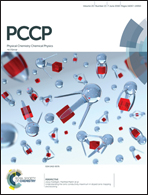La–La bonded dimetallofullerenes [La2@C2n]−: species for stabilizing C2n (2n = 92–96) besides La2C2@C2n†
Abstract
Recent reports pointed out that the formal La2C2n (2n = 92–106) series can exist stably as carbide cluster metallofullerenes (CCMFs) La2C2@C2n−2 with their successful crystallographic characterization. Herein, we suggest that the corresponding dimetallofullerenes (di-EMFs) La2@C2n possessing the lowest potential energies are also plausible candidates because of their favorability in statistical thermodynamics. This can be demonstrated in our present theoretical investigations on La2C94 and previously reported other La2C2n (2n = 92, 96–100) series by density functional theory calculations and statistical mechanics analyses. Nevertheless, it was noted that these thermodynamically favorable La2@C2n isomers turned out to be kinetically unstable radicals due to the presence of one unpaired electron on the carbon cage, making them missing fullerenes and difficult to be captured in their pristine forms, except for the experimentally obtained La2@D5(450)-C100 that has no unpaired electron. Such kinetic instability could be modified by electron reduction (the products were denoted as [La2@C2n]−) or other similar exterior functionalization with ˙CF3 and benzyl radicals, resulting in La–La bonded and paramagnetic species capable of being captured. On the basis of these approaches, carbon cages D3(85)-C92, Cs(120)-C94, D2(186)-C96, and C2(157)-C96 are predicted to be feasibly captured as both pristine CCMF species and electron reduced di-EMF derivatives.
![Graphical abstract: La–La bonded dimetallofullerenes [La2@C2n]−: species for stabilizing C2n (2n = 92–96) besides La2C2@C2n](/en/Image/Get?imageInfo.ImageType=GA&imageInfo.ImageIdentifier.ManuscriptID=C8CP01371C&imageInfo.ImageIdentifier.Year=2018)


 Please wait while we load your content...
Please wait while we load your content...